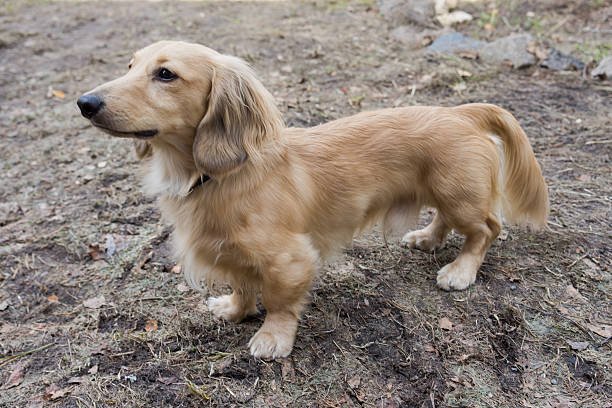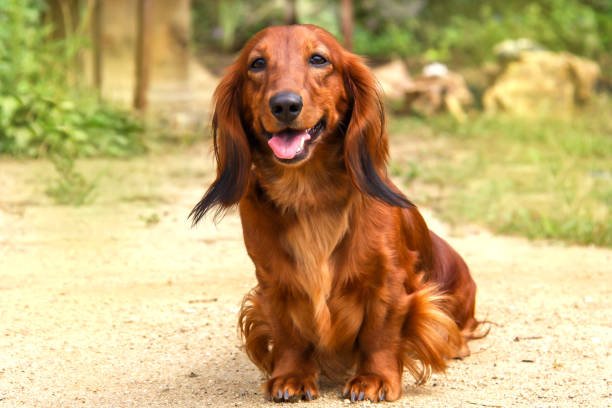
The Golden Weiner Dog, a delightful crossbreed between a Golden Retriever and a Dachshund, offers a perfect mix of two beloved breeds. With the Golden’s friendly, loyal nature and the Dachshund’s playful, curious personality, this hybrid brings out the best of both worlds. Their distinct appearance—combining the long body of a Dachshund with the soft coat of a Golden—makes them instantly recognizable and irresistibly charming. Loved for its affectionate temperament and adaptability, the Golden Weiner Dog has become a favorite choice for dog lovers seeking a loyal companion with a bit of flair.

The Golden Weiner Dog, also known as the Golden Retriever Dachshund mix, is a designer breed created by crossing the friendly Golden Retriever with the energetic Dachshund. This unique hybrid has gained popularity in recent years due to its playful nature and the blend of traits from two widely adored breeds. While not recognized by major canine associations like the AKC, the Golden Weiner Dog appeals to those seeking a smaller, loyal, and affectionate companion.
Physically, this mix can vary significantly, depending on which parent breed dominates. Most Golden Weiner Dogs tend to have the elongated body and shorter legs typical of the Dachshund while sporting a coat that resembles the Golden Retriever’s soft, wavy fur. Their size usually falls between the two parent breeds, making them medium-sized dogs, often weighing between 25 and 45 pounds. Coat colors can range from golden and cream to shades of brown or even black, further emphasizing their distinctive appearance. Though not officially recognized, the Golden Retriever Dachshund mix has gained a loyal following due to its unique combination of appearance and personality. These dogs inherit the best of both parent breeds, combining the Golden Retriever’s friendly, sociable nature with the Dachshund’s adventurous spirit.
The Golden Retriever, a breed renowned for its intelligence, agility, and rescue prowess, has a lineage that traces back to Scotland. Lord Tweedmouth, a Scottish nobleman, embarked on a breeding program in the late 19th century, crossing a male Golden Retriever with a female Tweed Water Spaniel named Belle. This union gave birth to the Golden Retriever, a breed that was initially recognized by the Kennel Club in England as the “Retriever – Yellow or Golden” in 1911. The breed’s official name, Golden Retriever, was adopted in 1920, and it gained further recognition by the American Kennel Club in 1932.
Meanwhile, across the English Channel, the Dachshund, a breed with a distinctive elongated body and short legs, has a history that dates back to 15th-century Germany. Originally known as the “badger dog” due to its ability to hunt wild boar, badgers, and foxes, the Dachshund was also used to flush cottontail rabbits. Over time, the breed was refined to become a fearless and agile canine capable of digging into badger burrows. The original Dachshund had a smooth coat and is believed to have descended from French Basset Hounds. In the 19th century, the breed gained popularity as a companion dog in Great Britain and was favored by European royal courts. To make the Dachshund more suitable as a pet, breeders reduced its size by approximately 10 pounds. A dog breed standard was established in 1879, and the Dachshund was introduced to the United States in 1885. The Dachshund Club of America was founded in 1895, and by the 1950s, the breed had become one of the most popular companion dogs in the United States.
The Golden Dachshund’s temperament is a unique blend of the Golden Retriever’s friendly and gentle nature with the Dachshund’s spirited and curious personality. This mix typically results in a dog that is both intelligent and loyal, making them highly trainable and eager to please. Golden Weiner Dogs are known for their adaptability, thriving in both active households and quieter environments, provided they get enough attention and stimulation.
In terms of energy levels, they inherit the playful side of both parent breeds. They enjoy regular exercise and interactive play but are also content to relax at home. Their affectionate nature makes them excellent companions for families, including those with children and other pets. However, they may also show some of the Dachshund’s independent streak, occasionally displaying a bit of stubbornness. Despite this, their overall temperament is friendly, sociable, and well-suited for a variety of living situations.

The Golden Dox, a charming blend of Golden Retriever and Dachshund, typically inherits a delightful mix of its parents’ best qualities. Like any dog breed, Golden Doxes have some potential health concerns to be aware of. It’s important to be aware of these potential problems to ensure your Golden Dox enjoys a long, happy, and healthy life. While generally healthy, they may inherit conditions common in their parent breeds. Intervertebral Disc Disease (IVDD), a serious spinal condition, is particularly concerning due to the Dachshund’s long back. Hip and elbow dysplasia, common in Golden Retrievers, can also occur. Eye conditions, such as Progressive Retinal Atrophy, cataracts, and glaucoma, are possible, as are allergies. Bloat, a life-threatening condition affecting deep-chested dogs, is another concern. Finally, obesity can exacerbate other health problems. To ensure your Golden Dox stays healthy, choose a responsible breeder who performs health screenings, schedules regular vet checkups, maintains a healthy weight with a balanced diet and exercise, and provides mental stimulation. By understanding these potential health concerns and taking proactive steps, you can help your Golden Dox thrive.
While Golden Doxes aren’t hypoallergenic, they’re relatively low shedders. Their coat can vary in length, so regular trims are necessary to keep things tidy. To prevent mats and tangles, plan on a professional grooming session every 4-6 weeks.
For at-home maintenance, daily brushing is key! Spend 10-15 minutes with a firm bristle brush to keep their coat healthy and shiny. Bathing can be done every 6-8 weeks, as this breed doesn’t tend to get smelly or drool excessively.
Don’t forget those ears! Weekly cleaning helps prevent infections. Nail trims and filing should be done every 2-3 weeks, and daily tooth brushing is a must for good oral health.
Golden Doxes are an energetic bunch, inheriting a playful spirit and boundless enthusiasm from their Golden Retriever and Dachshund parents. To keep them happy, healthy, and out of mischief, daily exercise is a must. Aim for at least 45-60 minutes of dedicated activity, which can include walks, playtime, running, swimming, dog park visits, or even hikes. Remember to vary the routine to keep things interesting for both you and your dog. Don’t forget about mental stimulation too! Engage their minds with training sessions, puzzle toys, and scent games to prevent boredom and promote overall well-being. A tired Golden Dox is a well-behaved Golden Dox, so prioritize both physical and mental exercise for a happy and harmonious life together.
Golden Doxes can indeed make wonderful family pets. Their playful nature and high energy levels make them a great fit for active households, especially those with children who can join in the fun and help keep them exercised. Their affectionate personalities mean they thrive on attention and love being involved in family activities. While generally friendly and good with other pets, early socialization is key, especially with cats. Their Dachshund heritage might trigger their instinct to chase smaller animals, so introducing them to cats while they’re young can help them build positive relationships. With proper training and socialization, Golden Doxes can bring a lot of joy to a family, offering companionship, playful energy, and lots of love.

Your Golden Dox may have a thick coat but don’t worry, they’re not heavy shedders! However, to keep their fur looking its best and prevent mats and tangles, daily brushing is essential. Think of it as a bonding session and a mini-massage—brushing not only removes loose hair but also distributes natural oils for a healthy shine and stimulates blood circulation.
While some Golden Doxes may require occasional trims to keep their fur tidy, others might need more frequent professional grooming, especially if their coat is prone to matting. And don’t forget those floppy ears! Regular cleaning and drying are crucial to prevent ear infections.
Finally, make toothbrushing a part of your daily routine. Using a pet-safe toothpaste can help keep those pearly whites healthy and ward off dental disease. With a little effort and regular care, your Golden Dox will be looking and feeling their best!
| Weight (lbs) | Daily Food (cups) | Notes |
| 20-30 | 1 – 1.5 | This is for moderately active adults. Adjust up/down as needed. |
| 30-40 | 1.5 – 2 | May need more if very active or if food is low-calorie. |
| 40-50 | 2 – 2.5 | Rare for a Golden Dox to be this big, but possible if the Golden Retriever genes are strong. |
Important Considerations:
So there you have it! Golden Doxes is a truly delightful mix of playful energy, loving companionship, and undeniable charm. If you’re searching for a furry friend who’s always up for an adventure, loves to cuddle, and will bring endless smiles to your face, then this might just be the perfect breed for you. Just be prepared for some serious playtime and maybe a few stubborn moments along the way. But hey, who doesn’t love a little bit of character in their canine companion? Happy Golden Dox adventures!
Read our popular articles:
Most Popular 21 Yellow Birds in NC: Facts and Identification
Choosing the Best Dog Food for Sensitive Skin in 2024: Tips from a Veterinarian
Join us on other social media platforms: